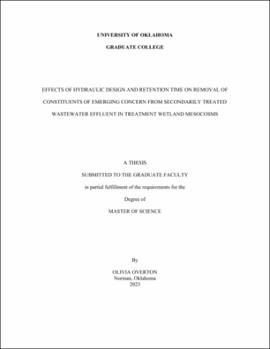| dc.description.abstract | Treatment wetlands (TWs) are an ecologically engineered, natural infrastructure approach designed specifically for water quality improvement via natural biogeochemical, physiochemical, and microbiological processes. The natural processes in TWs attenuate nutrients, total suspended solids, metals, and other chemical constituents. Along with more traditional water quality parameters, TWs have been shown to remove many types of constituents of emerging concern (CECs), a wide range of pharmaceutical, industrial, and agricultural compounds that are poorly removed in traditional wastewater treatment. The City of Norman, Oklahoma is considering the implementation of Indirect Potable Reuse (IPR) to augment water supply, and TWs are a possible treatment step for the removal of CECs from treated wastewater before discharge to a water supply. Hydraulic scheme (free-water surface (FWS), subsurface flow (SSF), and an open water control (OWC)), vegetation presence (planted and unplanted), and hydraulic retention time (HRT) (10-days, 5-days, and 3-days) were designed and manipulated in a 25-mesocosm TW compound to determine the impact of these design factors on the removal of the anti-seizure medication, carbamazepine, from secondarily treated wastewater. Traditional wastewater constituents like biochemical oxygen demand (BOD) and total suspended solids (TSS) and common physiochemical parameters were also monitored throughout the experiment. Carbamazepine concentrations were analyzed in the influent and effluent from the batch-reactor TW systems using enzyme-linked immunosorbent assay (ELISA) test kits. Longer HRTs were associated with increases in carbamazepine removal efficiency. TW mesocosm hydraulic design (FWS or SSF) was most significant to effluent carbamazepine concentration during the shortest HRT, 3-days (p = 0.005). The presence of vegetation did not significantly affect removal efficiency during this experiment (p = 0.975). Greater carbamazepine removal efficiencies were seen in this experiment than in previous studies, which could be due to the longer HRTs in the mesocosm-scale system or the availability of sorption sites on the fresh substrate. The results of this experiment provided promise for the effectiveness of TWs for the removal of carbamazepine and established a long-term experimental site for future TWs experiments. | en_US |
